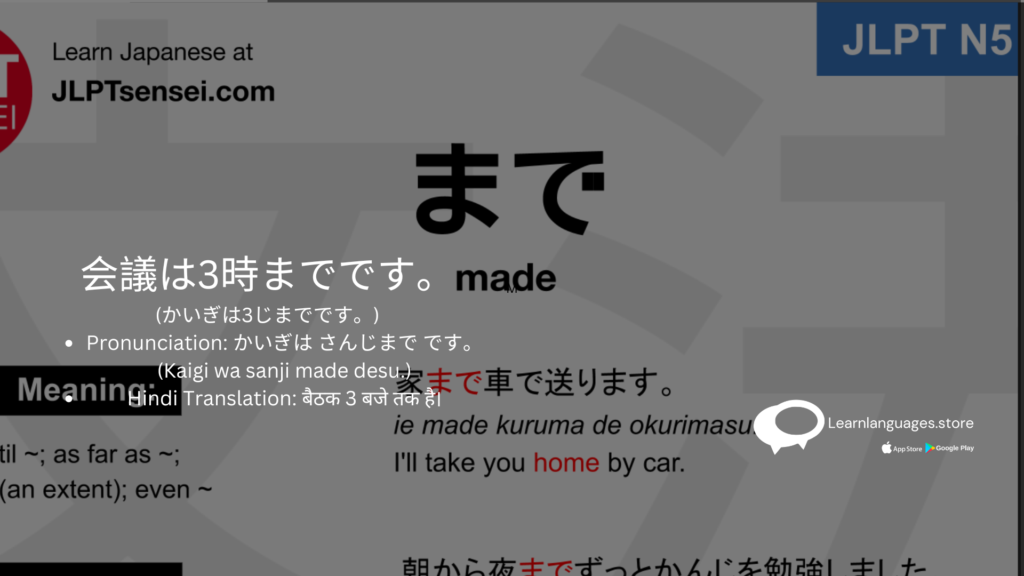Mastering 〜まで (made) in Japanese Grammar
Mastering 〜まで (made) in Japanese Grammar
Estimated reading time: 3 minutes
こんにちは (Konnichiwa)! Today, we’re diving into the versatile and essential Japanese particle 〜まで (made). This particle can be a real game-changer in your Japanese learning journey, as it is used to indicate “until” or “up to” a certain point in time, place, or extent. In this blog, we’ll break down the structure, usage, and exceptions of 〜まで (made) with plenty of funny and relatable examples to make your learning experience enjoyable. Let’s get started!

Understanding 〜まで (made)
Sentence Structure
The structure for using 〜まで (made) is quite straightforward. It can be attached to:
- Time expressions
- Locations
- Actions
The basic formula is:
- [Noun/Verb] + まで
Examples with Different Contexts
- Time Expression:
- Example: 午後5時まで働きます。(ごご5じまで はたらきます。)
- Pronunciation: ごごごじまで はたらきます。 (Gogo goji made hatarakimasu.)
- Hindi Translation: शाम 5 बजे तक काम करता हूँ।
- Humorous Twist: काम कर-कर के शाम 5 बजे तक मेरी हालत कबाड़ हो जाती है!
- Location:
- Example: 学校まで歩きます。(がっこうまで あるきます。)
- Pronunciation: がっこうまで あるきます。 (Gakkou made arukimasu.)
- Hindi Translation: स्कूल तक चलता हूँ।
- Humorous Twist: स्कूल तक चलते-चलते मेरी जूतों ने भी मुझसे कहा, “अब बस भी करो यार!”
- Action/Extent:
- Example: 泣くまで笑いました。(なくまで わらいました。)
- Pronunciation: なくまで わらいました。 (Naku made warai mashita.)
- Hindi Translation: रोने तक हँसा।
- Humorous Twist: इतनी जोर से हंसा कि पड़ोसी भी आकर बोले, “अब बस भी करो भाई, हँस-हँस के रो ही मत दो!”
Usage and Exceptions
General Usage
- Time Expressions:
- Used to indicate the end point of a time period.
- Example: 会議は3時までです。(かいぎは3じまでです。)
- Pronunciation: かいぎは さんじまで です。 (Kaigi wa sanji made desu.)
- Hindi Translation: बैठक 3 बजे तक है।
- Usage: It specifies the duration of the meeting until 3 PM.
- Location:
- Indicates the end point of a movement.
- Example: 駅まで走ります。(えきまで はしります。)
- Pronunciation: えきまで はしります。 (Eki made hashirimasu.)
- Hindi Translation: स्टेशन तक दौड़ता हूँ।
- Usage: Specifies running up to the station.
- Extent of an Action:
- Describes the extent or limit of an action.
- Example: 勉強して疲れるまで頑張ります。(べんきょうして つかれるまで がんばります。)
- Pronunciation: べんきょうして つかれるまで がんばります。 (Benkyou shite tsukareru made ganbarimasu.)
- Hindi Translation: पढ़ाई करता हूँ जब तक थक न जाऊँ।
- Usage: Indicates studying until getting tired.
Exceptions
While 〜まで (made) is versatile, be aware of similar particles like 〜から (kara, meaning “from”) which indicates the starting point. Using 〜まで (made) correctly ensures clarity in communicating the endpoint or limit.
Identifying 〜まで in a Sentence
Look for the particle 〜まで attached to nouns or verbs in a sentence, indicating the limit or endpoint of the time, place, or action.
Conclusion
In conclusion, 〜まで (made) is an invaluable particle in Japanese grammar, enabling you to express endpoints in time, locations, and actions effectively. By mastering its use, you can articulate your thoughts more clearly and accurately in Japanese. So, practice these examples, enjoy the humorous twists, and soon you’ll be using 〜まで (made) with confidence and finesse!
-
Product on sale
 Japanese N3
Japanese N3₹42,600.00
₹62,600.00 -
Product on sale
 Japanese N4
Japanese N4₹24,300.00
₹32,600.00 -
Product on sale
 Japanese N5
Japanese N5₹16,300.00
₹18,300.00
Learn Languages Store
Vashi,
Email: services@learnlanguages.store








